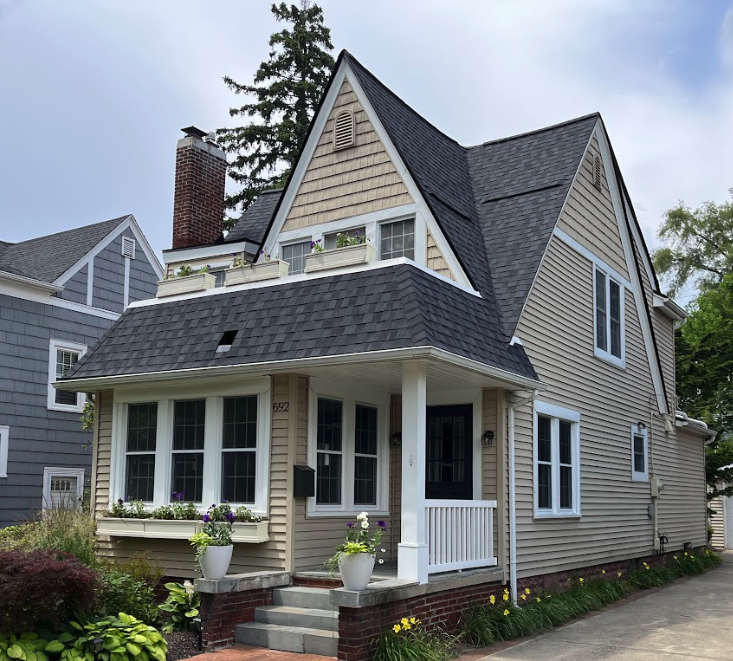Common Roofing Terms Every Homeowner Should Know
If you’ve ever gotten a roof estimate, you’ve probably heard words like “underlayment,” “flashing,” or “ridge vent.” For many homeowners, roofing terms can sound confusing or even intimidating. But when you’re investing in something as important as your roof, it helps to understand the basics.
At Level Up Improvement, a family-owned roofing company serving Oakland County and Metro Detroit, we believe clear communication builds trust. That’s why we’ve put together this guide to the most common roofing terms you’ll hear. Whether you’re planning a roof replacement, comparing estimates, or just want to know what’s protecting your home, this glossary will give you confidence.
Shingles
Shingles are the outermost layer of your roof—the part you see from the street. Most homes in Michigan use asphalt shingles, but premium products like CertainTeed Landmark Pro or Malarkey shingles offer added durability against our tough weather. Shingles protect your home from rain, snow, and sun while adding curb appeal.
Underlayment
Underlayment is a protective layer installed beneath your shingles. It acts as a moisture barrier in case water ever gets under the shingles. Think of it as your roof’s backup defense.
Decking (or Sheathing)
Decking is the layer of wood (usually plywood or OSB) that forms the base of your roof. Shingles and underlayment are nailed directly to it. If your decking is rotted, soft, or damaged, it often needs to be replaced during a roof replacement.
Flashing
Flashing is thin metal, usually aluminum or steel, installed around roof features like chimneys, skylights, and vents. Its job is to direct water away from those vulnerable areas. Without proper flashing, leaks are almost guaranteed.
Drip Edge
A drip edge is a metal strip installed along the edges of your roof. It helps direct water into the gutters and away from your fascia boards, preventing rot and water damage.
Fascia
Fascia is the vertical board that runs along the edge of your roof. It’s the part your gutters attach to. Besides supporting the gutters, fascia gives your roof a finished look.
Soffit
The soffit is the underside of your roof’s overhang. Many soffits are vented to allow airflow into your attic, which helps regulate temperature and prevent moisture buildup.
Ridge and Ridge Vent
The ridge is the peak where two roof slopes meet. A ridge vent runs along this peak, allowing hot, humid air to escape from your attic. Ridge vents are key for proper ventilation, especially in Michigan’s humid summers.
Valleys
A valley is where two roof slopes meet, creating a V-shape channel. Because valleys collect a lot of rain and snow, they’re some of the most vulnerable areas for leaks. That’s why professional installation and extra protection are critical.
Ice and Water Shield
This is a special waterproof underlayment installed in high-risk areas like valleys, eaves, and around chimneys. In Oakland County weather, where ice dams are common, ice and water shield is essential.
Gable
A gable is the triangular wall section formed at the end of a roof slope. Many homes in Southeast Michigan feature gable roofs, which are both functional and stylish.
Eave
The eave is the lower edge of the roof that extends beyond the walls of the house. Eaves help direct water away from the siding and foundation.
Hip Roof
A hip roof has slopes on all four sides that meet at the top to form a ridge. Hip roofs are more resistant to wind but require extra materials and labor compared to a simple gable roof.
Square
Roofers often measure jobs in “squares.” One roofing square equals 100 square feet of roof surface. If your roofer says your home is 20 squares, that means the roof covers about 2,000 square feet.
Nails and Fasteners
Not all nails are equal. The way shingles are fastened plays a big role in how well your roof performs. Family-owned companies often use higher-quality fasteners and careful hand-nailing techniques, giving you a roof that can better withstand Michigan storms.
Ventilation
Good ventilation helps regulate attic temperature and moisture. Without it, you can face ice dams in winter and overheated shingles in summer. Proper ventilation extends the lifespan of your roof and lowers energy bills. In order to have ideal ventilation a home needs to have both intake and exhaust ventilation. You cannot exhale without first inhaling, you’re roof is no different.
Warranty
Roof warranties can be confusing. Manufacturer warranties usually cover defects in the shingles, while workmanship warranties cover installation. Choosing a family-owned roofing company in Oakland County means you’ll get a team that stands behind both.
Why These Terms Matter
When you know the common roofing terms, you can:
-
Better understand roofing estimates
-
Spot the difference between quality and corner-cutting
-
Ask smarter questions before hiring a contractor
-
Protect your home with confidence
And when you work with a local, family-owned company like Level Up Improvement, you’ll never feel pressured or left in the dark. We take the time to explain what’s happening on your roof and why, so you always know you’re making the best decision for your home.
Final Thoughts
Roofing might seem complicated at first, but once you understand the key terms, it becomes much easier to follow along. From shingles and underlayment to flashing and ventilation, each part of your roof plays a role in protecting your home.
At Level Up Improvement, we’re proud to help Oakland County and Metro Detroit homeowners feel confident about their roofing projects. Whether you’re replacing your roof, repairing storm damage, or just learning more, we’re here with honest answers and quality work you can trust.

